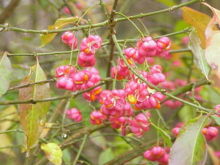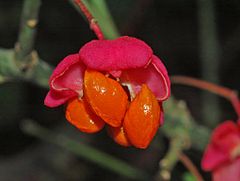- Euonymus europaeus
-
Euonymus europaeus 
European Spindle (Euonymus europaeus) Scientific classification Kingdom: Plantae (unranked): Angiosperms (unranked): Eudicots (unranked): Rosids Order: Celastrales Family: Celastraceae Genus: Euonymus Species: E. europaeus Binomial name Euonymus europaeus
L.Euonymus europaeus, known as spindle, and also as European spindle and common spindle, is a deciduous shrub or small tree in the family Celastraceae. Other names include Fusoria, Fusanum, Ananbeam, Shemshad Rasmi (Iran).
Contents
Description
Euonymus europaeus grows to 3 to 6 m tall, rarely up to 10 m, with a stem up to 20 cm diameter. The leaves are opposite, and are lanceolate to elliptical, 3 to 8 cm long and 1-3 cm broad, with a finely serrated edge. In autumn they often show a beautiful bright red colour.
The hermaphrodite flowers are produced in late spring and are insect-pollinated; they are rather inconspicuous, small, yellowish green and grow in cymes of 3-8 together. The capsular fruit ripens in autumn, and is red to purple or pink in colour and approximately 1 to 1.5 cm wide. When ripe, the four lobes split open to reveal the orange seeds.
The fruit is poisonous, containing amongst other substances, the alkaloids theobromine and caffeine, as well as an extremely bitter terpene. Poisonings are more common in young children, who are enticed by the brightly-coloured fruits. Ingestion can result in liver and kidney damage and even death.
Gallery
Distribution
This plant is native to much of Europe from Ireland and southern Scandinavia in the north, to northern Spain and Sicily in the south, and as far east as Lithuania, Asia Minor and up to the Caucasus.
Habitat
The European spindle prefers the edges of forest, hedges and gentle slopes, tending to thrive on nutrient-rich, chalky and salt-poor soils.
Cultivation and uses
European Spindle wood is very hard, and can be cut to a very sharp point; it was used in the past for making spindles for spinning wool.
It is a popular ornamental plant in gardens and parks due to its bright pink or purple fruits and attractive autumn colouring, in addition to its resistance to frost and wind. It has been introduced to North America where it has become an invasive species in some areas.
Parts of the plant have been used medicinally.[1]
Synonyms
- Euonymus multiflorus Opiz ex Bercht. [1838]
- Euonymus floribundus Steven [1856]
- Euonymus europaeus var. macrophyllus Rchb.
- Euonymus europaeus var. intermedius Gaudin
- Euonymus bulgaricus Velen. [1891]
- Euonymus vulgaris Mill. [1768]
- Euonymus angustifolius Clairv.[2]
References
External links
- "Spindle Wood (Euonymus Europaeus, L.)". British Wild Flowers. Chest of Books. 2009. http://chestofbooks.com/flora-plants/flowers/British-Wild-Flowers-1/Spindle-Wood-Euonymus-Europaeus-L.html. Retrieved 2009-09-24.
- "Euonymus europaeus L. European spindletree". Natural Resources Conservation Service. US Department of Agriculture. 2009. http://plants.usda.gov/java/profile?symbol=EUEU7. Retrieved 2009-09-24.
- "Euonymus europaeus European Euonymus Celastraceae". University of Connecticut Plant Database. University of Connecticut. http://www.hort.uconn.edu/plants/e/euoeur/euoeur1.html. Retrieved 2009-09-24.
Categories:- Euonymus
- Flora of Europe
Wikimedia Foundation. 2010.






